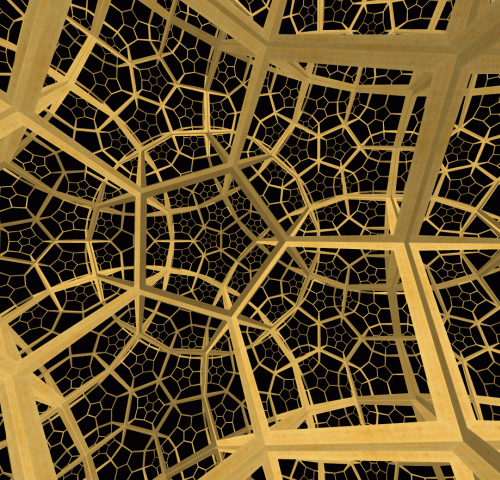
Figure 1. John Conway reaches into a 4-dimensional object, the 120-cell, as Marc Pelletier watches.
Ed Pegg Jr., December 18, 2006
A recent column by Ivars Petersen, Quark Park, showed various pictures of a 4-dimensional sculpture by Marc Pelletier. This sculpture, a 120-cell, was dedicated to mathematician John Conway. Below is a photo from the event. The 120-cell is to the dodecahedron as a tesseract (MathWorld, Wikipedia, Cut the Knot, Geometry Center) is to a cube -- it's the 4-D extension. 4 lines make a square, 6 squares make a cube, 8 cubes make a tesseract. 120 dodecahedra make a 120-cell.

Figure 1. John Conway reaches into a 4-dimensional object, the 120-cell, as Marc
Pelletier watches.
Marc's history with the 120-cell goes back to when he was 17 years old, when he discovered that an early version of the Zome construction system could make an accurate model of the 120-cell. While still a teenager, he co-founded Zome with Paul Hildebrandt. His sculpture above was partially inspired by Paul Donchian (1895-1967), a dealer of oriental carpets who provided all of the wire frame models for H. S. M. Coxeter's 1949 book Regular Polytopes.

Figure 2. Donchian's 1940-era display with a 120-cell as a centerpiece.
Another exploration program by Roice Nelson allows you to try many different visualizations of the 120-cell. Below, one of the many visualizations peels away some of the dodecahedra. Each dodecahedron touches exactly 12 others. Four dodecahedra meet at each corner.

Figure 3. From the
Explore the 120-Cell program.
Another 120-Cell visualizer is the beautiful Jenn3D
program by
Fritz Obermeyer and Willy Winkel, with subtitle "For visualizing
Coxeter Polytopes." According to Jenn's Catalog of Uniform
Polytopes, the Coxeter notation for the dodecahedron is ![]() ,
for the icosahedron is
,
for the icosahedron is ![]() ,
and for the 120-cell is
,
and for the 120-cell is ![]() .
Jenn allows a full exploration of Coxeter notations.
.
Jenn allows a full exploration of Coxeter notations.

Figure 4. Coxeter's 120-Cell (![]() )
as rendered by
Jenn3D.
)
as rendered by
Jenn3D.
The 120-Cell has been shown on TV. In this scene from Numb3rs episode "The OG," actor Peter MacNicol is holding a metal 120-cell made by Bathsheba Grossman. The original design is by George Hart.

Figure 5. A 120-cell by Bathsheba
Grossman, as shown on Numb3rs.
A viewer of the slices of 3-D stellations of the 120-cell is available as a Java applet at Mark Newbold's Hyperspace Star Polytope Slicer. One image from shell 15 of the stellation is shown below.

Figure 6. A polytope slice of
a stellation of a 120-cell, by Mark Newbold.
So far, I haven't ventured into hyperbolic space. The Poincaré disk; also called the Lobachevskian, L2, or hyperbolic plane; allows either 4 pentagons or 5 quadrilaterals to meet at a corner. These images were made with Mathematica, with assistance from notebook "Tessellations of the Euclidean, Elliptic and Hyperbolic Plane."


Figure 7. Hyperbolic tilings with pentagons and quadrilaterals.
When hyperbolic tilings are brought into the next dimension, 3-manifolds are the result. The program Curved Spaces 3 by Jeff Weeks allows the visualization of what happens when 8 dodecahedra meet at each corner. Notice that hyperbolic pentagon tiling above in figure 7 is repeated in figure 8 to make curved planes. Another view is available as a part of Not Knot.

Figure 8. Hyperbolic dodecahedra, as seen by Curved Spaces
3.
Plato (Timaeus 55), after describing the other four Platonic
solids, said "There still remained a fifth construction, which the god
used for embroidering the constellations on the whole heaven." Other philosophers
assigned the dodecahedron to the cosmos. I wonder how Plato would have liked the
visualization programs I mention above.
George Hart, "4D Polytopes and 3D Models of Them," http://www.cs.sunysb.edu/~cse125/notes/08-4D-Forms.ppt.
George Hart, "4D Polytope Projection Models by 3D Printing," May 3, 2002. http://www.georgehart.com/hyperspace/hart-120-cell.html.
Paul Hildebrandt, "Zome-inspired Sculpture," http://www.lkl.ac.uk/bridges/Zome-Hildebrandt.pdf.
Roice Nelson, "Explore the 120-Cell," July 1, 2006. http://www.gravitation3d.com/120cell/.
Mark Newbold, "Hyperspace Star Polytope Slicer," Feb 1, 2003. http://www.dogfeathers.com/java/hyperstar.html.
Fritz Obermeyer, "Jenn 3d," http://www.math.cmu.edu/~fho/jenn/.
Marc Pelletier, "Paul Donchian, Modeler of Higher Dimensions," Fields Institute Presentation, February 15, 2002. http://www.fields.utoronto.ca/audio/01-02/sculpture/pelletier/.
Ivars Petersen, "Math Trek: Quark Park," Nov 11, 2006. http://www.sciencenews.org/articles/20061111/mathtrek.asp.
Miodrag Sremcevic, Radmila Sazdanovic, and Srdjan Vukmirovic, "Tessellations of the Euclidean, Elliptic and Hyperbolic Plane," Wolfram Information Center, March 23, 2003. http://library.wolfram.com/infocenter/MathSource/4540/.
John Stillwell, "The Story of the 120-Cell," Notices of the AMS, Jan 2001. http://www.ams.org/notices/200101/fea-stillwell.pdf.
Jeff Weeks, Curved Spaces 3, Dec 2006. http://www.geometrygames.org/CurvedSpaces/.
Andrew Weimholt, "120-Cell Foldout," http://www.weimholt.com/andrew/120.html.
Comments are welcome. Please send comments to Ed Pegg Jr. at ed@mathpuzzle.com.
Ed Pegg Jr. is the webmaster of mathpuzzle.com. He works at Wolfram Research, Inc. as an associate editor of MathWorld. He is also a math consultant for the TV show Numb3rs.